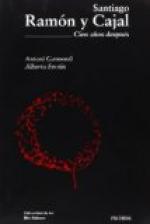|
This section contains 1,377 words (approx. 5 pages at 300 words per page) |

|
World of Biology on Santiago Ramn y Cajal
The anatomical research of the Spanish neurohistologist Santiago Ramón y Cajal is central to the modern understanding of the nervous system. By adopting and improving the nervous-tissue staining process developed by the Italian scientist Camillo Golgi, Ramón y Cajal established that individual nerve cells, or neurons, are the basic structural unit of the nervous system. He also made important discoveries relating to the transmission of nerve impulses and the cellular structures of the brain. For his work in histology, the branch of anatomy concerned with minute tissue structures and processes, Ramón y Cajal shared with Golgi the 1906 Nobel Prize for physiology or medicine.
Ramón y Cajal was born on May 1, 1852, in the remote country village of Petilla de Aragon, Spain. He was the son of Justo Ramón y Casasús, a poor and self-educated barber-surgeon, and Antonia...
|
This section contains 1,377 words (approx. 5 pages at 300 words per page) |

|


